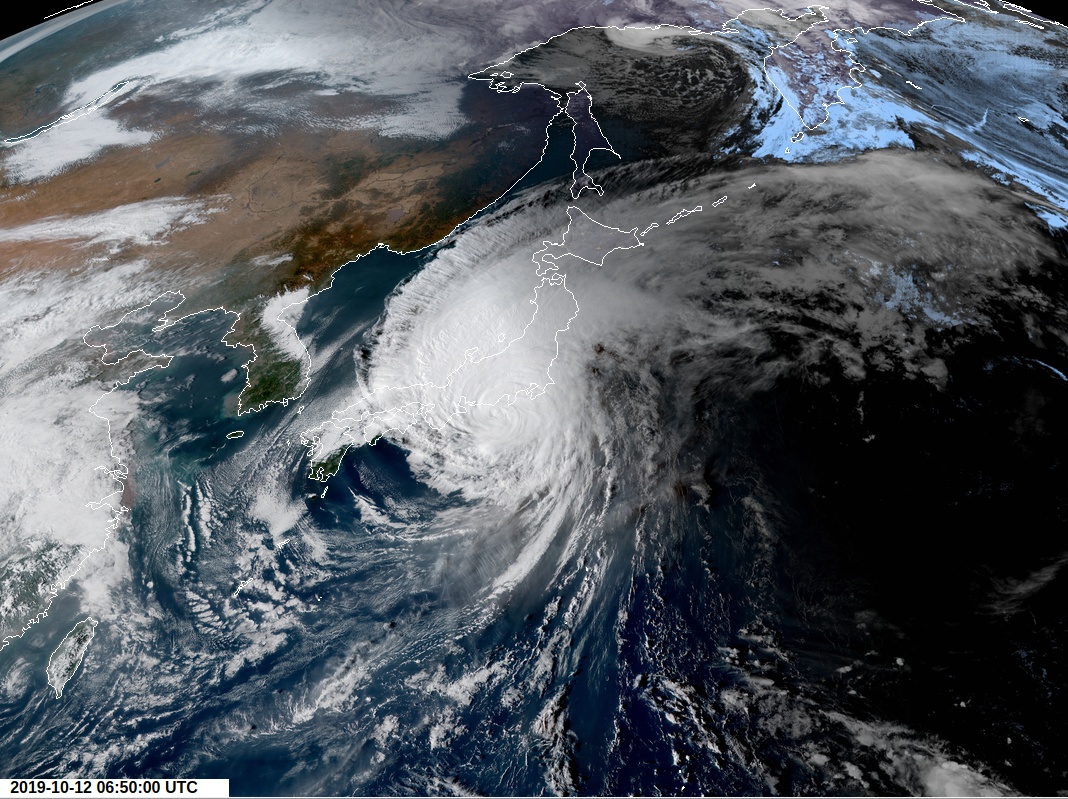Widespread floods after extreme rainfall brought by Typhoon “Hagibis” – dozens dead or missing, Japan

Typhoon "Hagibis" made landfall near Izu Peninsula in Japan's Shizuoka Prefecture, just southwest of Tokyo, shortly before 10:00 UTC (19:00 LT) on October 12, 2019, bringing extremely heavy rain and wind of 144 km/h (90 mph), Category 2 hurricane equivalent on the Saffir-Simpson Hurricane Wind Scale. A major rescue operation, including more than 27 000 Self-Defense Force personnel, was underway in central, eastern and northeastern regions. Officials are still gathering information and trying to determine the total number of casualties. At least 26 people have died, 16 are missing and at least 166 have been injured, as of 10:25 UTC on October 13. Hagibis has caused immense damage far and wide in eastern Japan, government spokesman Yoshihide Suga said.
This was one of the strongest typhoons to ever hit Tokyo and the strongest since 1958. The affected area stretches for more than 1 000 km (620 miles).
"Be ready for rainfall of the kind that you have never experienced," the Japan Meteorological Agency (JMA) said ahead of the storm. JMA emphasized that areas usually safe from disasters may prove vulnerable.
As predicted, the typhoon dumped exceptionally heavy rain, more than 1 m (39 inches) in places or 30 to 40% of average annual rainfall in just 24 and 48 hours.
The resort town of Hakone in Kanagawa Prefecture recorded 942.3 mm (37.1 inches) in 24 hours on October 12, setting a record for that location. 685.8 mm (27 inches) of rain was registered in heavily forested Shizuoka Prefecture southwest of Tokyo. Downtown Tokyo received unusually high 203.2 mm (8 inches) of rain in the same period. Higher elevations just west of downtown Tokyo registered record 599.4 mm (23.6 inches) of rain.
The Ministry of Land, Infrastructure, Transport and Tourism confirmed 48 landslides and mudflows in 12 prefectures and the collapse of levees at 10 locations on 9 rivers by 12:00 LT, October 13.
Of those, 6 rivers under state jurisdiction suffered levee breaches at 7 locations – the Yoshida River in the vicinity of Miyagi Prefecture's Osato-cho, 2 locations on the Kuji River in the vicinity of the city of Hitachiomiya in Ibaraki Prefecture, the Toki River in the vicinity of Higashi Matsuyama in Saitama Prefecture, the Oppe River in the vicinity of Kawagoe in Saitama Prefecture, the Tsukumo River in the vicinity of Higashi Matsuyama in Saitama, and the Chikuma River in the vicinity of the city of Nagano. The 3 other locations are at 3 rivers under the jurisdiction of Tochigi Prefecture.
More than 6 million people across Honshu were advised to evacuate before the storm. 800 000 households in Tokyo alone. Many people decided to ignore warnings and stay in their homes.
The hardest-hit areas include the city of Nagano, where Chikuma River burst its banks, causing massive flooding. Some of the residential areas there were estimated to be under 5 m (16.4 feet) of water.
Self-Defense Forces spokesperson said Sunday they are still carrying out rescue work in Tokyo and seven other prefectures.
Lives continue to be affected by disruptions to power, water and transportation services, Chief Cabinet Secretary Yoshihide Suga said.
More than 430 000 homes were left without power at the height of the storm. Around 200 000 homes in metropolitan Tokyo (population 38 million) are still without power, 90 100 in Chiba and 26 300 in Kanagawa, as of Sunday morning (UTC). Power outages are also reported in Ibaraki, Shizuoka, Tochigi, Yamanashi, Gunma and Saitama prefectures.
More than 14 000 customers are without water.
A destructive tornado touched down in Ichihara, Chiba, killing 1 person, destroying 12 houses and damaging more than 70 others.
A Panamanian cargo ship with 12 crew members sank in Tokyo Bay around 21:40 LT on Saturday. 4 of them were rescued and 2 confirmed dead by Sunday morning.
Japanese authorities had repeatedly warned Hagibis is comparable to the devastating typhoon of 1958 which left 1 269 people dead and 500 000 homes flooded.
Thanks to safety infrastructure and modernization, the number of casualties caused by Hagibis is not comparable to similar typhoons in the history of Japan.




Prior to making landfall, Hagibis underwent the strongest quick intensification of any tropical cyclone from the western Pacific in at least 23 years.
1983 Super Typhoon "Forest" had winds intensifying from 121 km/h (75 mph) Category 1 to 282 km/h (175 mph) Category 5 in a period of 24 hours. Hagibis' rapid intensification is equivalent to nearly three and a half times the rate a storm would require to strengthen.
During the height of its intense strengthening, Hagibis became a major hurricane-level typhoon in just six hours.
Only a few previous hurricanes topped Hagibis' shocking intensification rate.
2015 Hurricane "Patricia" had increased winds from 137 km/h (85 mph) to 193 km/h (120 mph) in 24 hours, which became the most powerful hurricane on record in the Western Hemisphere with maximum winds up to 346 km/h (215 mph). Hagibis' rate is comparable to that of Patricia.
Updates
October 14, 06:33 UTC
The death toll has reached 42 and the number of injured 198, according to NHK. There are at least 15 people missing.
Land ministry said levees along 21 rivers collapsed.
Tokyo Electric Power Co. said 56 800 homes were still without electricity Monday in Tokyo and nearby prefectures that the utility serves, AFP reports. Tohoku Electric Power Co. said 5 600 homes were without power in Miyagi, Iwate, Fukushima and Niigata.
October 15, 07:54 UTC
The death toll jumped to 66 on October 15 and the number of injured to over 200. 15 people remain missing.
The highest toll was in Fukushima prefecture north of Tokyo, where levees burst in at least 14 places along the Abukuma River, which meanders through a number of cities in the largely agricultural prefecture, Reuters reports. At least 25 people died in Fukushima, including a mother and child who were caught in floodwaters, NHK said.
October 16, 08:50 UTC
At least 74 people have been confirmed dead.
More than 13 000 homes were submerged and 1 100 at least partially destroyed.
More than 100 landslides were reported across the country.
Featured image: Rescue operations after Typhoon "Hagibis" hits Japan on October 12, 2019. Credit: Kyodo (still shot)

RESCUING JAPAN AND THE REST OF THE WORLD FROM NUCLEAR HOLOCAUST
I HAVE WARNED MANY TIMES SINCE THE BEGINNING OF THIS YEAR THAT JAPAN WILL BE ENFORCED TO SHUT DOWN ITS NUCLEAR POWER PLANTS BY THE MIDDLE OF NEXT YEAR (2020). IN FACT, NOT ONLY JAPAN THAT WILL BE ENFORCED TO SHUT DOWN ITS NUCLEAR POWER PLANTS BUT ALSO THE US AND OTHER COUNTRIES AS WELL. HOWEVER, I HAVE CONTACTED SEVERAL CORPORATIONS, ORGANIZATIONS AND GOVERNMENT AGENCIES IN JAPAN INCLUDING JAPAN ATOMIC ENERGY AGENCY URGING THEM TO TAKE MY PROPOSED CONDENSED MATTER NUCLEAR REACTOR SERIOUSLY. IT IS THE ONLY ENERGY SOURCE THAT CAN REPLACE THE WHOLE POWER GENERATED FROM CURRENT NUCLEAR POWER PLANTS AND AT THE SAME TIME PREVENT NUCLEAR HOLOCAUST. JAPAN POSSESSES HIGH-TECH INDUSTRIES AND IT CAN MASS-PRODUCE THE PROPSED REACTOR IN A SHORT PERIOD OF TIME. HOWEVER, THE RAPID MIGRATION OF EARTH’ S MAGNETIC FIELD WILL ACCELERATE FURTHER AND THAT WILL CAUSE BIGGER AND MORE DEVASTATING STORMS AND ALSO GEOLOGICAL UPHEAVAL AROUND THE GLOBE, ESPECIALLY AROUND THE RING OF FIRE. WITHOUT A DOUBT, SOME OF THE NUCLEAR POWER PLANTS IN JAPAN AND THE US, IF NOT MOST OF THEM WILL BECOME EXPLODED NUCLEAR BOMBS IF THEY ARE NOT SHUT DOWN IN THE NEAR FUTURE
More Details R Necessary ……………….